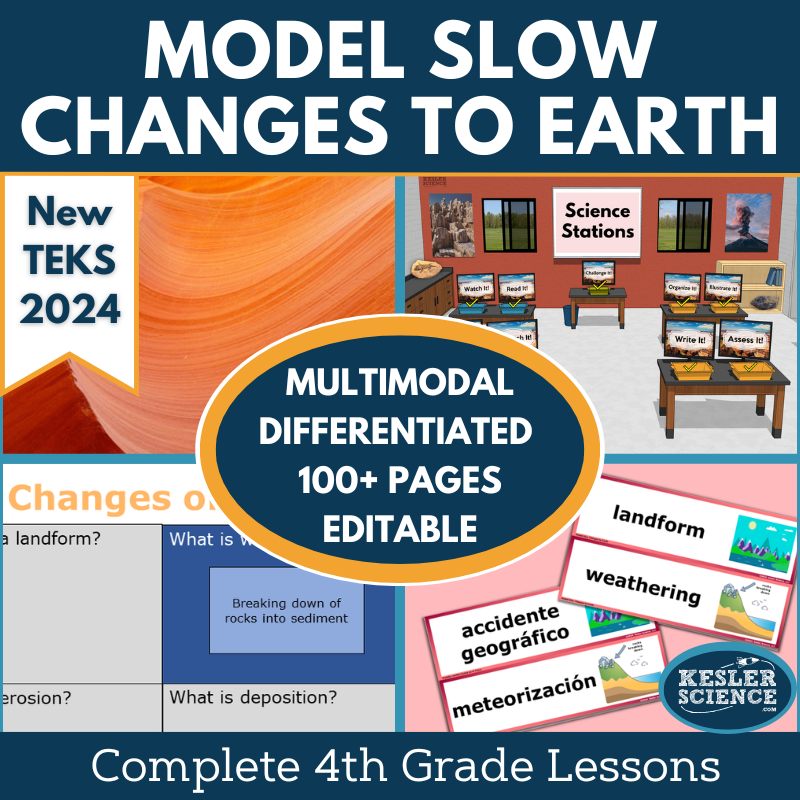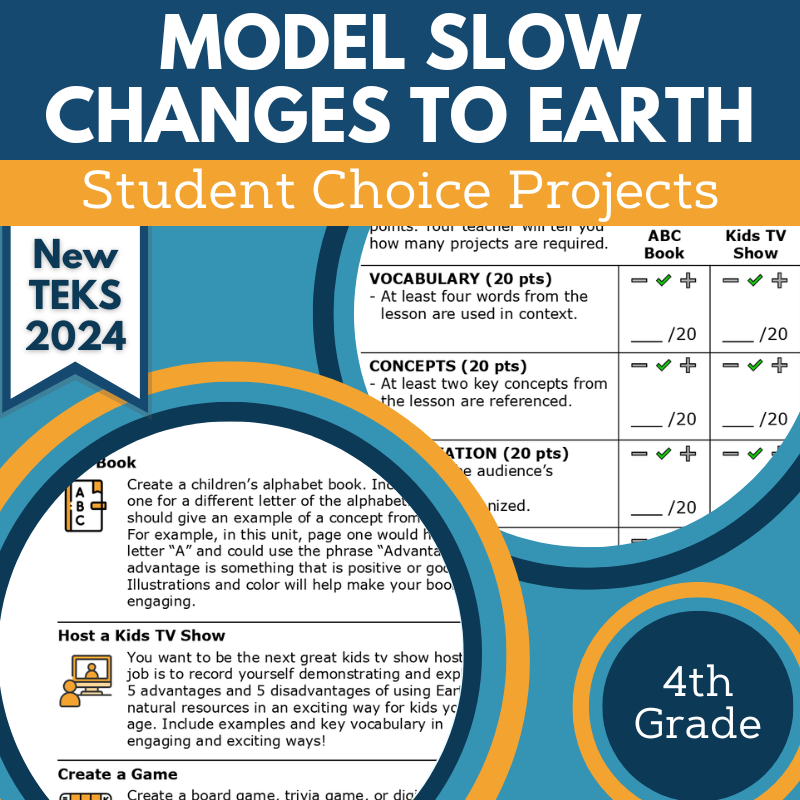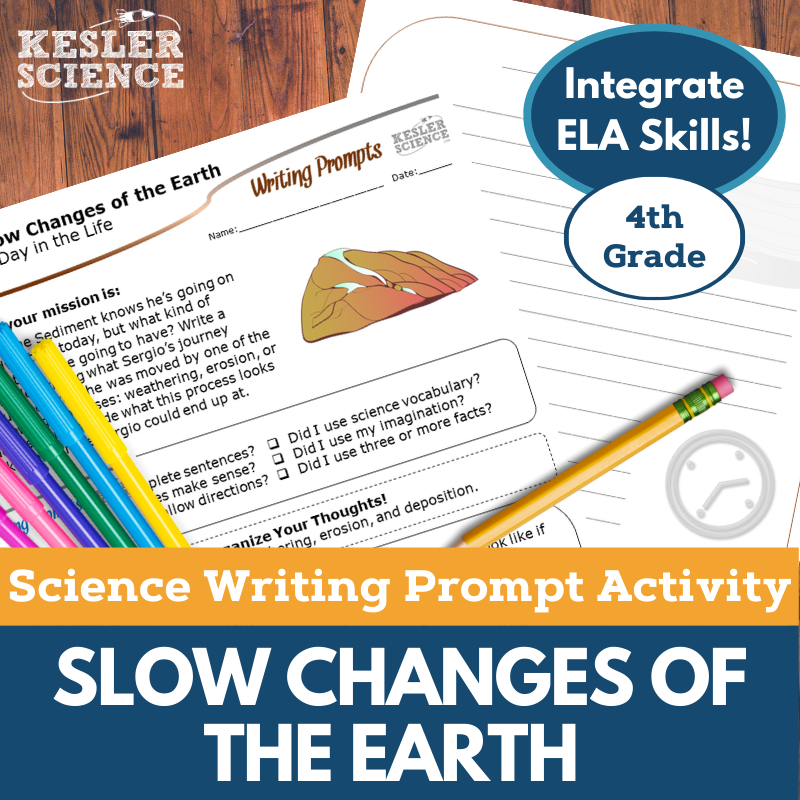Model Slow Changes to Earth Activities for 4th Grade Science
This 4th-grade geology unit helps students model and describe slow changes to Earth's surface caused by weathering, erosion, and deposition from water, wind, and ice, aligning with the 2021 TEKS 4.10B standard. The resources below will give students a comprehensive understanding of slow changes to Earth's surface. All of the following materials are also included in the Kesler Science Membership.
The Kesler Science Model Slow Changes to Earth unit for 4th grade focuses on modeling and describing slow changes to Earth's surface caused by weathering, erosion, and deposition from water, wind, and ice. This fully editable, low-prep lesson includes presentations, worksheets, choice projects, and assessments designed for differentiated, student-led learning aligned with the 2021 TEKS 4.10B standard.
Following the 5E Model, the lesson begins with engaging objectives and vocabulary in English and Spanish, along with class discussions and activities. During exploration, a nine-station, student-led lab offers multimodal learning experiences through hands-on demos, readings, videos, and research tasks. Output stations allow students to demonstrate understanding through organizing, writing, drawing, and assessments. Bonus challenge stations offer enrichment opportunities.
The explanation phase features editable PowerPoints, interactive notebook templates, and note-taking guides. Students extend learning through creative choice projects and demonstrate mastery with STAAR 2.0-aligned assessments, review questions, and worksheets. The materials are flexible for both classroom and virtual environments.
The Kesler Science Model Slow Changes to Earth unit for 4th grade focuses on modeling and describing slow changes to Earth's surface caused by weathering, erosion, and deposition from water, wind, and ice. This fully editable, low-prep lesson includes presentations, worksheets, choice projects, and assessments designed for differentiated, student-led learning aligned with the 2021 TEKS 4.10B standard.
Following the 5E Model, the lesson begins with engaging objectives and vocabulary in English and Spanish, along with class discussions and activities. During exploration, a nine-station, student-led lab offers multimodal learning experiences through hands-on demos, readings, videos, and research tasks. Output stations allow students to demonstrate understanding through organizing, writing, drawing, and assessments. Bonus challenge stations offer enrichment opportunities.
The explanation phase features editable PowerPoints, interactive notebook templates, and note-taking guides. Students extend learning through creative choice projects and demonstrate mastery with STAAR 2.0-aligned assessments, review questions, and worksheets. The materials are flexible for both classroom and virtual environments.
Engage your 4th-grade students with this interactive, student-led station lab aligned with the 2021 TEKS 4.10B standard. Designed to explore Earth’s gradual processes—erosion, deposition, and weathering—this resource encourages students to take charge of their own learning through hands-on and inquiry-based activities. The lesson promotes critical thinking as students describe the forces that shape Earth’s surface and model these natural changes over time.
The station lab features nine differentiated activities that allow students to work independently or in small groups, either in person or virtually. Input stations help students encounter new concepts through a variety of methods: Explore It! offers hands-on learning, Watch It! engages students with a video and questions, Read It! provides reading passages with comprehension questions in both English and Spanish, and Research It! presents facts, images, and graphs for deeper exploration. These stations are designed to cater to various learning styles and ensure that every student can engage with the material effectively.
Students demonstrate their understanding through output stations, where they apply their knowledge using different methods. They organize information with manipulatives in Organize It!, draw visual representations of Earth’s processes in Illustrate It!, and respond to prompts in Write It! using complete sentences. The Assess It! station challenges students with questions and vocabulary exercises, while a bonus Challenge It! station offers extension activities such as crosswords, games, and mini projects for advanced learners. This flexible, low-prep resource supports active learning and can be adapted for both classroom and virtual environments.
Engage your 4th-grade students with this interactive, student-led station lab aligned with the 2021 TEKS 4.10B standard. Designed to explore Earth’s gradual processes—erosion, deposition, and weathering—this resource encourages students to take charge of their own learning through hands-on and inquiry-based activities. The lesson promotes critical thinking as students describe the forces that shape Earth’s surface and model these natural changes over time.
The station lab features nine differentiated activities that allow students to work independently or in small groups, either in person or virtually. Input stations help students encounter new concepts through a variety of methods: Explore It! offers hands-on learning, Watch It! engages students with a video and questions, Read It! provides reading passages with comprehension questions in both English and Spanish, and Research It! presents facts, images, and graphs for deeper exploration. These stations are designed to cater to various learning styles and ensure that every student can engage with the material effectively.
Students demonstrate their understanding through output stations, where they apply their knowledge using different methods. They organize information with manipulatives in Organize It!, draw visual representations of Earth’s processes in Illustrate It!, and respond to prompts in Write It! using complete sentences. The Assess It! station challenges students with questions and vocabulary exercises, while a bonus Challenge It! station offers extension activities such as crosswords, games, and mini projects for advanced learners. This flexible, low-prep resource supports active learning and can be adapted for both classroom and virtual environments.
The Modeling Slow Changes to Earth Student Choice Projects align with the 2021 TEKS Earth science standard 4.10B, offering 4th-grade students a range of project options to match their preferred output style. A project page outlines six student-led options and a “design your own” project, with an editable rubric for teacher, peer, or self-assessment. This resource is also part of the Model Slow Changes to Earth Complete Lesson for TEKS 4.10B.
These flexible, multimodal projects allow students to creatively demonstrate their understanding, with two versions of the project page supporting differentiation. Modified options assist students needing remediation, while advanced learners can take on additional challenges using the same rubric.
The resource includes nine project choices, a “design your own” option, a teacher directions page, and editable rubric pages assessing vocabulary, concepts, presentation, clarity, and accuracy. Projects use standard classroom supplies like paper, markers, and scissors, and many options can be completed digitally.
The Modeling Slow Changes to Earth Student Choice Projects align with the 2021 TEKS Earth science standard 4.10B, offering 4th-grade students a range of project options to match their preferred output style. A project page outlines six student-led options and a “design your own” project, with an editable rubric for teacher, peer, or self-assessment. This resource is also part of the Model Slow Changes to Earth Complete Lesson for TEKS 4.10B.
These flexible, multimodal projects allow students to creatively demonstrate their understanding, with two versions of the project page supporting differentiation. Modified options assist students needing remediation, while advanced learners can take on additional challenges using the same rubric.
The resource includes nine project choices, a “design your own” option, a teacher directions page, and editable rubric pages assessing vocabulary, concepts, presentation, clarity, and accuracy. Projects use standard classroom supplies like paper, markers, and scissors, and many options can be completed digitally.
The Slow Changes of Earth Science and ELA Integrated Writing Activity engages 4th-grade students in creatively demonstrating their understanding of Earth's surface changes through a “day in the life” writing prompt. This activity encourages science reasoning and exploration while enhancing writing skills, making it ideal for both in-person and virtual learning.
Aligned with TEKS and NGSS standards, this low-prep, student-centered resource is perfect for elaboration, review, or enrichment. It includes teacher directions with answer guides, project ideas, and rubrics; projection-friendly prompts for classroom or virtual display; full-sized and half-sheet handouts for various uses; and a digital interactive PowerPoint version, compatible with Google Slides.
This versatile activity can be used for cross-curricular projects, formative assessments, early finisher tasks, extra credit, make-up work, TELPAS samples, or differentiation exercises. It also works well for classroom displays or as part of a student anthology. Designed for review, it assumes students have prior knowledge of the topic or access to research materials.
The Slow Changes of Earth Science and ELA Integrated Writing Activity engages 4th-grade students in creatively demonstrating their understanding of Earth's surface changes through a “day in the life” writing prompt. This activity encourages science reasoning and exploration while enhancing writing skills, making it ideal for both in-person and virtual learning.
Aligned with TEKS and NGSS standards, this low-prep, student-centered resource is perfect for elaboration, review, or enrichment. It includes teacher directions with answer guides, project ideas, and rubrics; projection-friendly prompts for classroom or virtual display; full-sized and half-sheet handouts for various uses; and a digital interactive PowerPoint version, compatible with Google Slides.
This versatile activity can be used for cross-curricular projects, formative assessments, early finisher tasks, extra credit, make-up work, TELPAS samples, or differentiation exercises. It also works well for classroom displays or as part of a student anthology. Designed for review, it assumes students have prior knowledge of the topic or access to research materials.
The WIKI Tickets© formative assessments offer a fun and engaging way to check 3rd–5th grade students’ understanding of Earth and Space Science. This set includes 33 assessments, each available in five formats: a full-screen projection version, three printable handouts (full, split, and quarter-page sizes), and an interactive digital version compatible with PowerPoint and Google Slides.
Aligned with NGSS and TEKS standards for upper elementary science, each standard is covered by at least one ticket, with some topics featuring multiple assessments. A table of contents is also included to show standard alignment. These versatile assessments can be used in both classroom and virtual learning environments.
Topics include air temperature, wind direction, precipitation, Earth’s rotation, natural resources, weather patterns, soil properties, the water cycle, and more. WIKI Tickets© can serve as exit tickets, bellringers, or quick checks for understanding. They can be projected for whole-class participation, printed for individual use, or assigned digitally in 1:1 or remote learning settings.
The WIKI Tickets© formative assessments offer a fun and engaging way to check 3rd–5th grade students’ understanding of Earth and Space Science. This set includes 33 assessments, each available in five formats: a full-screen projection version, three printable handouts (full, split, and quarter-page sizes), and an interactive digital version compatible with PowerPoint and Google Slides.
Aligned with NGSS and TEKS standards for upper elementary science, each standard is covered by at least one ticket, with some topics featuring multiple assessments. A table of contents is also included to show standard alignment. These versatile assessments can be used in both classroom and virtual learning environments.
Topics include air temperature, wind direction, precipitation, Earth’s rotation, natural resources, weather patterns, soil properties, the water cycle, and more. WIKI Tickets© can serve as exit tickets, bellringers, or quick checks for understanding. They can be projected for whole-class participation, printed for individual use, or assigned digitally in 1:1 or remote learning settings.
Year-Round Resources
These year-round activities will increase your students' understanding of many middle school science topics. All of these activities are also included in the Kesler Science Membership.
Visual Data & Graphing
You're not alone if your students struggle with understanding graphs, charts, and tables. It's a skill that takes an enormous amount of practice. This resource will help students build a strong foundation in analyzing data and creating their own data visualizations.
Bell Ringers and Warm-Ups
These middle school science bell ringers are an excellent way to engage your students as soon as they walk into your classroom. This comprehensive FULL YEAR resource includes everything you need to start off each science class with an interesting warm-up activity.
Review Board Games
Each game board has been carefully designed to keep students engaged. There are 10 different action spaces on each board and dozens of question cards. All of the actions are related to science concepts and keep the students motivated throughout the game.
Each game is ready to play. Simply print out the board and the cards and let the students enjoy reviewing nine different units.
Essential Questions and Standards
Below are the essential questions and standards associated with the lessons and activities included in the atoms unit. This topic is only one of more than 100 middle school science topics included in the Kesler Science Membership.
-
How can we model the processes that slowly change Earth’s surface?
-
Can you describe the forces and processes that slowly change Earth’s surface?
-
TEKS Science - 4.10B Model Slow Changes to Earth
Kesler Science Membership
Imagine never having to search for another middle school science lesson again. The membership gives you access to ALL of the Kesler Science products in one place (Yes, including everything above).
Say goodbye to long hours of lesson prep.











